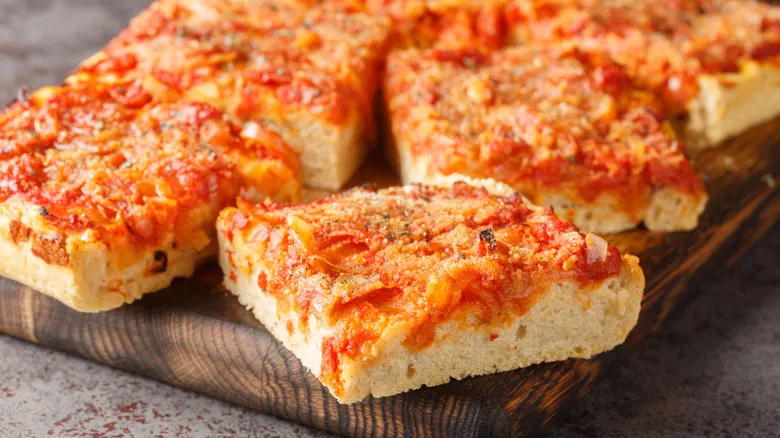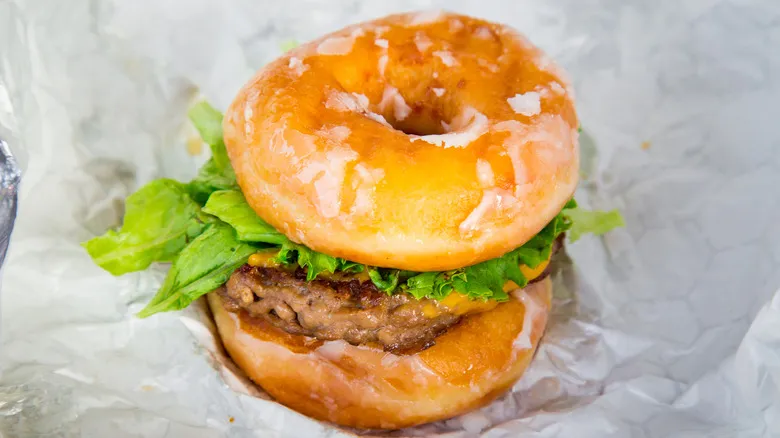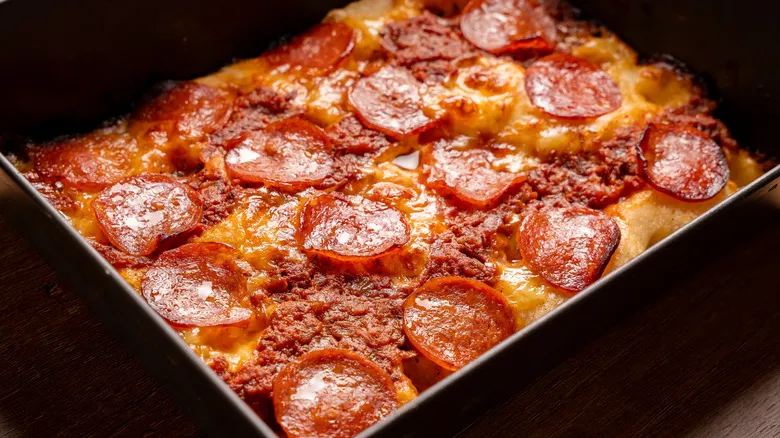Detroit-style pizza has brick cheese with sauce on top

Detroit-style pizza is commonly described as square, though it is actually more rectangular in shape. It is baked in industrial pans that were originally used in Detroit's factories to transport bolts and other small items. While these specific pans are harder to find today, they are not strictly necessary for making authentic Detroit-style pizza.
Typically, a Detroit-style pizza features a thick crust that is light and airy due to the dough being double-proofed, giving it a spongy texture reminiscent of focaccia. In this regard, Detroit pizzas share similarities with Sicilian pizzas, although some argue that the dough in Detroit-style is slightly more moist than its Sicilian counterpart.
The toppings are where Detroit-style pizza significantly differs from its Sicilian relative. It traditionally uses brick cheese, a high-fat cheese from Wisconsin that has a flavor profile closer to cheddar, although some variations do include classic mozzarella. Tomato sauce is a key component, but the choice of additional toppings can vary—pepperoni is a classic option, but not mandatory. Buddy's, a restaurant in the Detroit area known as the birthplace of this pizza, offers a diverse selection of traditional toppings such as peppers, olives, mushrooms, and sausage. Notably, the arrangement of toppings is inverted compared to most other pizza styles: the cheese is placed at the bottom, followed by toppings like pepperoni, with the tomato sauce on top to prevent the crust from becoming soggy.
Sicilian pizza layers sauce underneath the cheese

There are two distinct styles of Sicilian pizza worth knowing. The first is the traditional version found in Sicily, Italy, known as sfincione, which translates to "thick sponge" in Italian. This name describes the dough, which resembles focaccia and is thick and airy, similar to Detroit-style pizza. It is also rectangular, like its Detroit counterpart. However, the toppings set it apart from the Detroit pie. The classic sfincione features a sauce made from tomatoes, onions, anchovies, olive oil, and various seasonings, including garlic, basil, oregano, and crushed red pepper. It is then topped with breadcrumbs and caciocavallo, a hard Italian cheese made from sheep or cow's milk, comparable to provolone, though its flavor intensity varies with aging. Unlike Detroit-style pizza, the toppings are layered traditionally, with the sauce on the bottom and cheese on top. It is baked in a well-greased olive oil pan, resulting in a crispy crust.
The second version of Sicilian pizza developed from the original in New York. While the dough and shape remain largely unchanged, the toppings have evolved. The sauce is now a simpler tomato blend made with tomatoes, olive oil, garlic, and seasonings like oregano and crushed red pepper, omitting onions and anchovies, and is spread directly on the crust. Instead of caciocavallo, mozzarella is used due to its widespread availability in New York, and you won't find breadcrumbs on the American Sicilian pie. Some restaurants may also offer additional toppings like pepperoni.
Recommended

How Restaurant Etiquette Differs Around The World

How The Doughnut Bacon Cheeseburger Got Its Name From An R&B Legend

Elvis' 9 Favorite Southern Comfort Foods

Why Chocolate Mousse Was Once Referred To As Mayonnaise
Next up

